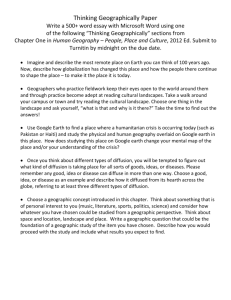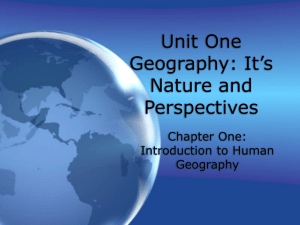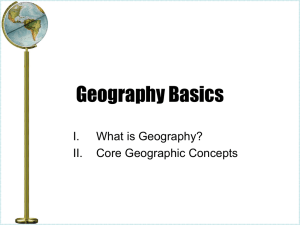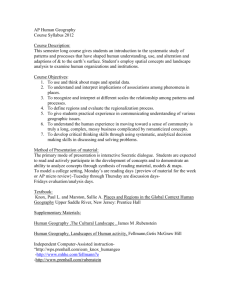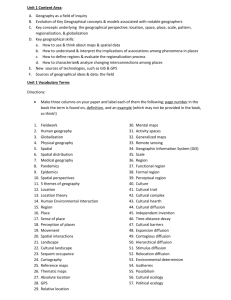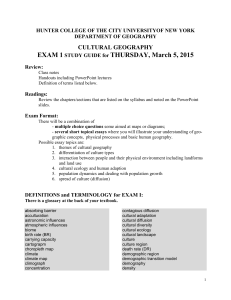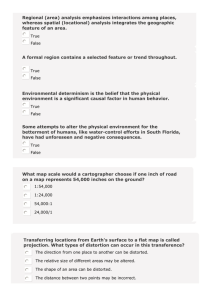AP Human Geography - Lake County Schools
advertisement
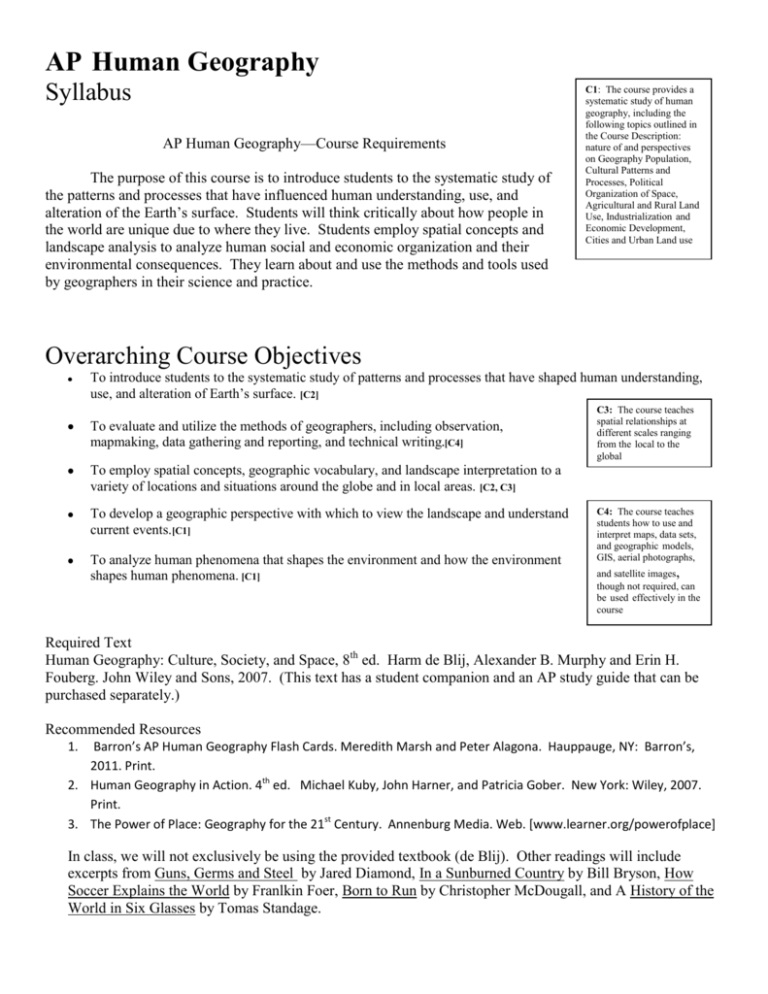
AP Human Geography Syllabus AP Human Geography—Course Requirements The purpose of this course is to introduce students to the systematic study of the patterns and processes that have influenced human understanding, use, and alteration of the Earth’s surface. Students will think critically about how people in the world are unique due to where they live. Students employ spatial concepts and landscape analysis to analyze human social and economic organization and their environmental consequences. They learn about and use the methods and tools used by geographers in their science and practice. C1: The course provides a systematic study of human geography, including the following topics outlined in the Course Description: nature of and perspectives on Geography Population, Cultural Patterns and Processes, Political Organization of Space, Agricultural and Rural Land Use, Industrialization and Economic Development, Cities and Urban Land use Overarching Course Objectives To introduce students to the systematic study of patterns and processes that have shaped human understanding, use, and alteration of Earth’s surface. [C2] To evaluate and utilize the methods of geographers, including observation, mapmaking, data gathering and reporting, and technical writing.[C4] C3: The course teaches spatial relationships at different scales ranging from the local to the global To employ spatial concepts, geographic vocabulary, and landscape interpretation to a variety of locations and situations around the globe and in local areas. [C2, C3] To develop a geographic perspective with which to view the landscape and understand current events.[C1] To analyze human phenomena that shapes the environment and how the environment shapes human phenomena. [C1] C4: The course teaches students how to use and interpret maps, data sets, and geographic models, GIS, aerial photographs, and satellite images, though not required, can be used effectively in the course Required Text Human Geography: Culture, Society, and Space, 8th ed. Harm de Blij, Alexander B. Murphy and Erin H. Fouberg. John Wiley and Sons, 2007. (This text has a student companion and an AP study guide that can be purchased separately.) Recommended Resources 1. Barron’s AP Human Geography Flash Cards. Meredith Marsh and Peter Alagona. Hauppauge, NY: Barron’s, 2011. Print. 2. Human Geography in Action. 4th ed. Michael Kuby, John Harner, and Patricia Gober. New York: Wiley, 2007. Print. 3. The Power of Place: Geography for the 21st Century. Annenburg Media. Web. [www.learner.org/powerofplace] In class, we will not exclusively be using the provided textbook (de Blij). Other readings will include excerpts from Guns, Germs and Steel by Jared Diamond, In a Sunburned Country by Bill Bryson, How Soccer Explains the World by Franlkin Foer, Born to Run by Christopher McDougall, and A History of the World in Six Glasses by Tomas Standage. A wide variety of activities will be utilized to encourage learning in the classroom. Articles from newspapers and journals will gathered and recorded in journals. Students will create maps from information they gather, trace migration patterns, keep a travel journal, debate, write research papers, and produce oral reports and discussions. Websites Used The following websites are used for research and supplemental data in planning and implementing instruction. U.S. Census Bureau – www.census.gov Digital Atlas of the United States http://130.166.124.2/USpage1.html 1997 Agricultural Atlas of the United States www.nass.usda.gov/census/census97/atlas97/ National Atlas www.nationalatlas.gov Maryland: Where do we Grow from Here http://dnr.maryland.gov/education/growfromhere/TOC.HTM National Geographic Society www.nationalgeographic.com Population Reference Bureau www.prb.org Population Connection www.populationconnection.org Saudi Aramco World www.saudiaramcoworld.com United Nations www.un.org World Health Organization http://www.who.int/en/ World Bank www.worldbank.org Course Sequence This is a one semester course that meets daily for 90 minutes. The semester is comprised of 90 instructional days. The following is an outline of the main units in the course with corresponding instructional time. Unit I. Geography; Its Nature and Perspectives II. Population M/C Coverage on AP Exam Readings Time 5-10% De Blij Ch 1 5 Days 13-17% De Blij, Ch 2 & 3 12 Days III. Cultural Patterns and 13-17% De Blij, Ch 4-7 Processes IV. Political 13-17% De Blij, Ch 8 Organization of Space V. Agricultural and Rural 13-17% De Blij, Ch 11 Land Use VI. Industrialization & 13-17% De Blij, Ch 9 & 13 Economic Activity VII. Urbanization and 13-17% De Blij, Ch 10 & 12 Industrialization *remaining 10 days reserved for testing, field trips and schedule disruptions 20 Days 13Days 10 Days 10 Days 10 Days Student Evaluation Each unit of study includes reading quizzes for chapters in the text, labs and other activities, with a major paper or project each term and unit tests. Grading is broken into two categories: Assessments – which include tests, quizzes, FRQs; Assignments – projects, vocabulary and labs. Each assignment has a point weight and each category makes up 50% of the overall grade. There will be a final exam for the course in June. A = 90-100% B = 80-89% C=70-79% D=60-69% F=below 60 Grading System (per semester) Essays and Homework-----------------20% Research Paper/Oral Report-----------20% Midterm and Final----------------------20% Chapter Tests and Quizzes------------30% Participation-----------------------------10% Unit Outlines Unit I. Geography; Its Nature and Perspectives Abstract: This unit will focus on the relevancy of geography to everyday life and utilizing geographic tools. Geographic concepts emphasized are location, space, place, scale, pattern, regionalization and specialization. Data analysis of geographic phenomena will be emphasized as well. Objectives: Define geography, human geography; explain the meaning of the spatial perspective. Explain how geographers classify each of the following and provide examples of each: distributions, locations, regions. Identify how each of the following plays a role in mapmaking: simplification, categorization, symbolization, induction. Identify types of scale and projections used in mapmaking; identify advantages and disadvantages of different projections. List different types (models) of diffusion and provide examples/illustrations of each in the real world. Distinguish between different types of maps and mapped information (e.g., dot distribution, choropleth, etc.) and provide explanations of strengths and weaknesses of each. Focus Questions: 1. Why do Geographers Address Where Things Are? 2. Why is Each Point on Earth Unique? 3. Why are Different Places Similar? Unit Plan I. Geography: Its Nature and Perspectives (5 Days) A. Thinking about Space B. Thinking about Place C. Thinking about Region D. Thinking about Scale E. Thinking about Connections Required Reading • De Blij, Chapter 1: “Thinking Geographically” Vocabulary: Changing attributes of place (built landscape, sequent occupance) Cultural attributes (cultural landscape) Density (arithmetic, physiological) Diffusion (hearth, relocation, expansion, hierarchical, contagious, stimulus) Direction (absolute, relative) Dispersion/concentration (dispersed/scattered, clustered/agglomerated) Distance (absolute, relative) Distribution Environmental determinism Location (absolute, relative, site, situation, place name) Pattern (linear, centralized, random) Physical attributes (natural landscape) Possibilism Region (formal/uniform, functional/nodal, perceptual/vernacular) Scale (implied degree of generalization) Size Spatial (of or pertaining to space on or near Earth’s surface) Spatial interaction (accessibility, connectivity, network, distance decay, friction of distance, time-space compression) Geographic Tools Distortion Geographic Information System (GIS) Global Positioning System (GPS) Grid (North and South Poles, latitude, parallel, equator, longitude, meridian, prime meridian, international date line) Map (Maps are the tool most uniquely identified with geography; the ability to use and interpret maps is an essential geographic skill.) Map scale (distance on a map relative to distance on Earth) Map types (thematic, statistical, cartogram, dot, choropleth, isoline) Mental map Model (a simplified abstraction of reality, structured to clarify causal relationships): Geographers use models (e.g., Demographic Transition, Epidemiological Transition, Gravity, Von Thünen, Weber, Stages of Growth [Rostow], Concentric Circle [Burgess], Sector [Hoyt], Multiple Nuclei, Central Place [Christaller], and so on) to explain patterns, make informed decisions, and predict future behaviors. Projection Remote sensing Time zones Unit II. Population and Migration Abstract: This unit will investigate the spatial phenomena of diffusion of people and human characteristics on the Earth’s surface. Use of data to analyze population pyramids and generate hypothesis about aging in individual societies. Evaluate the push and pull factors of migration. Objectives: Map major and emerging population concentrations and describe demographic characteristics of each Consider the concepts of ecumene and nonecumene and consider: a) Why do most people live where they do? b) For what reasons have humans historically avoided certain areas? c) Where do nonexamples of each exist? Why? Calculate arithmetic, agricultural, and physiological densities and describe the strengths and weaknesses of each for demographic analysis. Explain the elements of a population pyramid and distinguish between characteristic shapes. Explain the demographic transition model: a) What are its components? b) Which countries does it describe in each phase? c) Why might it not predict the future for developing countries today? Give examples of pro- and antinatalist policies and their effects in example countries. Define key demographic terms and identify regions in which high and low extreme examples of each can be found. Concerning natural hazards, do the following: a) list various types of natural hazards and disasters b) map the areas most affected by them c) compare with the map of population distribution Focus Questions 1. 2. 3. 4. 5. 6. 7. 8. Where is the World’s Population Distributed? Where Has the world’s population increased? Why is population increasing at different rates in different countries? Why might the world face an overpopulation problem? Why do people migrate Where are migrants distributed? Why do Migrants face obstacles? Why do people migrate within a country? Unit Plan II. Population Geography (12 Days) A. Where the World’s Population Is Distributed [C2] B. Where the World’s Population Has Increased [C2] C. Population Is Increasing at Different Rates in Different Countries D. Demographic Transition Model [C4] E. The World Might Face an Overpopulation Problem F. Why People Migrate G. Distribution of Migrants [C2] H. Obstacles Faced by Migrants I. People Migrate Within a County C2: The course teaches the use of spatial concepts and landscape analysis to examine human organization of space C4: The course teaches students how to use and interpret maps, data sets, and geographic models, GIS, aerial photographs, and satellite images, though not required, can be used effectively in the course Required Reading and Activities • De Blij, Chapters 2 and 3: “Population” and “Migration” • PRB Web site: “Making Population Real: New Lesson Plans and Classroom Activities” [http://prb.org/Educators/] Obituary Activity: Using obituaries from the local newspaper, have students plot on a map where people were born and where they died. [C4] Have them use the following key to sort data according when people were born: Before 1920, 1920–1945, 1946–1965, 1966 to present. Draw lines, using the color for the birth year, from places of birth to the local region. Have students analyze the patterns and relate them to migration trends. [C4] (For example, most people born before 1920 came to Oregon from the Midwest while more people who were born from 1966 to the present came from Latin America and Asia.) Helpful reading for teacher: Bailey, Adrian, Making Population Geography. London: Hodder & Stoughton Educational, 2005. Vocabulary Population Age distribution Carrying capacity Cohort Demographic equation Demographic momentum Demographic regions Demographic Transition model Dependency ratio Diffusion of fertility control Disease diffusion Doubling time Ecumene Migration Activity space Chain migration Cyclic movement Distance decay Forced Gravity model Internal migration Intervening opportunity Epidemiological Transition model Gendered space Infant mortality rate J-curve Maladaptation Malthus, Thomas Mortality Natality Neo-Malthusian Overpopulation Population densities Population distributions Population explosion Population projection Population pyramid Rate of natural increase S-curve Sex ratio Standard of living Sustainability Underpopulation Zero population growth Migration patterns • Intercontinental • Interregional • Rural-urban Place utility Push-pull factors Refugee Space-time prism Step migration Transhumance Transmigration Voluntary Migratory movement Periodic movement Personal space Unit III Cultural Patterns and Processes Abstract: This unit will cover the basics concepts of cultural geography, methods of diffusion, and the impact of culture on the environment and the environment on culture. The diffusion of language and religion will also be explored. Issues surrounding ethnicity and conflict arising from cultural traits will also be studied from a geographic perspective. Objectives: Define culture and cultural geography. Compare and contrast the following aspects of folk and popular culture: a) origins b) methods of diffusion c) culture regions Examine specific examples of folk culture and regions. Examine examples of specific popular cultural traits and discuss their diffusion. Discuss ways in which cultural traits are affected by and affect the natural environment. Discuss the role of racism and ethnocentrism in the understanding of the cultural landscape. Language: Discuss the importance and role of language as an element of culture. Explain how languages are classified and related. Map the distribution of major language families worldwide Show the division of Europe into the following language groups and give specific examples from major groups: a) Germanic b) Slavic c) Romance Describe the following characteristics of English: a) origin and historical development b) worldwide diffusion c) spatial variation d) role in cultural convergence Explain the how, why, and where of language change. Discuss the regional and local variety in language using the following terms: a) slang b) isogloss c) accent Explain how toponyms are derived and classified and give various examples. Religion Identify the following characteristics of all major religions: a) point of origin b) method of diffusion c) current distribution d) landscape expression Map the religious regions of the United States. Discuss the major branches, their origins, and their current distributions for the following religions: a) Christianity b) Islam c) Buddhism Distinguish between ethnic and universalizing religions: a) holy sites b) holy days c) methods of diffusion Describe ways in which the environment influences religion and ways in which religions affect the natural environment. Discuss various specific religious conflicts around the world in terms of the following: a) religion versus politics b) religion versus religion—interfaith conflicts c) religion versus religion—intrafaith conflicts Focus Questions: 1. Where do folk and popular cultures originate and diffuse? 2. Why is folk culture clustered? 3. Why is popular culture widely distributed? 4. What role does television play in diffusing popular culture? 5. What role does technology such as the Internet play in diffusion of popular culture? 6. How does government control of technology impact the spread of popular culture? 7. Why does globalization of popular culture cause problems? 8. What is the environmental impact of popular culture? 9. Where are English language speakers distributed and why? 10. Why is English related to other languages and how? 11. Where are other language families distributed and why? 12. Why do people preserve local languages? 13. Where are religions distributed? 14. Why do religions have different distributions? 15. Why do religions organize space indistinctive patterns and what are these patterns? 16. Why do territorial conflicts arise among religious groups? 17. Where are ethnicities distributed? 18. Why have ethnicities been transformed into nationalities? 19. Why do ethnicities clash? 20. What is ethnic cleansing, where and why has it taken place? III. Cultural Patterns and Processes (20 Days) A. Folk and Pop Culture (5 Days) 1. Where Folk and Popular Cultures Originate and Diffuse 2. Folk and Popular Culture and the Cultural Landscape [C2] 3. Folk Culture Is Clustered 4. Popular Culture Is Widely Distributed 5. Globalization of Popular Culture Causes Problems C2—The course teaches the use of spatial concepts and landscape analysis to examine human organization of space Required Reading and Activities - De Blij, Chapter 4: “Folk and Popular Culture” B. Language (5 Days) 1. Where English Language Speakers Are Distributed 2. Indo-European Languages 3. Where Other Language Families Are Distributed 4. People Preserve Local Languages Required Reading - De Blij, Chapter 6: “Language” C. Religion (5 days) 1. Universalizing and Ethnic Religions 2. Origin and Diffusion of Religions [C4] 3. Religions Organize Space C4—The course teaches students how to use and interpret maps, data sets, and geographic models. GIS, aerial photographs, and satellite images, though not required, can be used effectively in the course. Required Reading • De Blij, Chapter 7: “Religion” • Szulc, Tad, “Abraham: Journey of Faith,” National Geographic (December, 2001): pp. 90– 129. • “Islam: An Introduction”, A special pull-out section, Saudi Aramco World (January/February 2002). D. Ethnicity (5 Days) 1. Distribution of Ethnicities [C4] 2. Why Some Ethnicities Have Been Transformed into Nationalities 3. The Clash of Ethnicities Required Reading • De Blij, Chapter 5: “Ethnicity” • individual articles from Refugees magazine, published by the UN Refugee Agency (UNHCR), online at http://www.unhcr.org/ Vocabulary Concepts of Culture Acculturation Assimilation Cultural adaptation Cultural core/periphery pattern Cultural ecology Cultural identity Cultural landscape Cultural realm Culture Culture region • Formal—core, periphery • Functional—node • Vernacular (perceptual)—regional self-awareness Diffusion types • Expansion— hierarchical, contagious, stimulus • Relocation Innovation adoption Maladaptive diffusion Folk and Popular Culture Adaptive strategies Anglo-American landscape characteristics Architectural form Built environment Folk culture Folk food Folk house Folk songs Folklore Material culture Nonmaterial culture Popular culture Survey systems Traditional architecture Language Creole Dialect Indo-European languages Isogloss Language Language family Language group Language subfamily Lingua franca Linguistic diversity Monolingual/multilingual Official language Pidgin Toponymy Trade language Religion Animism Buddhism Cargo cult pilgrimage Christianity Confucianism Ethnic religion Exclave/enclave Fundamentalism Geomancy (feng shui) Hadj Hinduism Interfaith boundaries Islam Jainism Judaism Landscapes of the dead Monotheism/polytheism Mormonism Muslim pilgrimage Muslim population Proselytic religion Reincarnation Religion (groups, places) Religious architectural styles Religious conflict Religious culture hearth Religious toponym Sacred space Secularism Shamanism Sharia law Shintoism Sikhism Sunni/Shia Taoism Theocracy Universalizing Zoroastrianism Ethnicity Acculturation Adaptive strategy Assimilation Barrio Chain migration Cultural adaptation Cultural shatterbelt Ethnic cleansing Ethnic conflict Ethnic enclave Ethnic group Ethnic homeland Ethnic landscape Ethnic neighborhood Ethnicity Ethnocentrism Ghetto Plural society Race Segregation Social distance Gender Dowry death Enfranchisement Gender Gender gap Infanticide Longevity gap Maternal mortality rate Unit IV Political Organization of Space Abstract: This unit focuses on the political organization of the world; how regions are defined and identified, case studies of political conflicts, the rise of nations, states and nation-states. Also evaluated will be the problems faced by stateless nations and multinational states. Additionally the impact of colonialism and imperialism will be analyzed. Objectives: Describe the distribution of major ethnicities within the United States: a) identify states/regions in which they are clustered b) identify regions in which they are mostly absent c) provide reasons for the present distribution Examine case studies of ethnic conflicts from different regions. Consider ways in which gender-related issues are expressed spatially, particularly: a) economic roles and activity b) health and reproduction c) level of education Discuss various nation-state configurations and illustrate them with examples: a) nation-state b) part-nation state c) multinational state d) stateless nation Explain the concept of state by: a) identifying necessary qualifications and characteristics b) listing examples of states in various regions c) describing quasi-states Describe the problems of multinational states and stateless nations. List advantages and disadvantages of different types of boundaries and provide real-world examples of: a) natural/physical boundaries b) cultural boundaries c) geometric boundaries List advantages and disadvantages of different shapes of states and provide examples. Discuss the concepts of imperialism and colonialism and illustrate some of their consequences on the contemporary political map. Define irredentism and devolution and illustrate with examples. Summarize the history of the United Nations and identify issues of current importance regarding it. Focus Questions: 1. 2. 3. 4. Where are states located and why? Why do boundaries cause problems? What are the basic shapes of states and how does shape impact political conflict/stability? What are the basic types of political boundaries and how are they used to divide territory; what problems arise from this division? 5. How are states organized from within; what are the basic organization of states within their boundaries? 6. Why do states cooperate with each other? 7. What types of political and military cooperation do states engage in? 8. What forms of economic cooperation exist and how do they impact the relationship between and amongst states? 9. What roles do states play in terrorism and terrorism play in states? 10. Why has terrorism increased over time? 11. Why would states support terrorism? Unit Plan IV. Political Geography (13 Days) A. The Difference Between a State and a Nation B. Boundaries [C4][C2] C. Boundary Problems D. Cooperation Between States [C3] E. A Look at Terrorism Required Reading and Activities C2—The course teaches the use of spatial concepts and landscape analysis to examine human organization of space C3—The course teaches spatial relationships at different scales ranging from the local to the global • De Blij, Chapter 8: “Political Geography” C4—The course teaches students how to use and interpret maps, data sets, and geographic models. GIS, aerial photographs, and satellite images, though not required, can be used effectively in the course. Vocabulary: Annexation Antarctica Apartheid Balkanization Border landscape Boundary, disputes (definitional, locational, operational, allocational) Boundary, origin (antecedent, subsequent, superimposed, relic) Boundary, process (definition, delimitation, demarcation) Boundary, type (natural/physical, ethnographic/cultural, geometric) Buffer state Capital Centrifugal Centripetal City-state Colonialism Confederation Conference of Berlin (1884) Core/periphery Decolonization Devolution Domino theory EEZ (Exclusive Economic Zone) Electoral regions Enclave/exclave Ethnic conflict European Union Federal Forward capital Frontier Geopolitics Gerrymander Global commons Heartland/rimland Immigrant states International organization Iron Curtain Irredentism Israel/Palestine Landlocked Law of the Sea Lebanon Mackinder, Halford J. Manifest destiny Median-line principle Microstate Ministate Nation National iconography Nation-state Nunavut Raison d’être Reapportionment Regionalism Religious conflict Reunification Satellite state Self-determination Shatterbelt Sovereignty State Stateless ethnic groups Stateless nation Suffrage Supranationalism Territorial disputes Territorial morphology (compact, fragmented, elongated, prorupt, perforated) Territoriality Theocracy Treaty ports UNCLOS (United Nations Convention on the Law of the Sea) Unitary USSR collapse Women’s enfranchisement Unit V. Agricultural and Rural Land Use Abstract: This unit focuses on how people utilize the land for agricultural purposes. Students will evaluate levels of development in nations and analyze why these different levels exist. An analysis of the evolution of agricultural practices and origin and identification of various hearths will be studied. The distribution of settlements will also be evaluated. Objectives: Use examples of human welfare indicators to distinguish between relatively developed and less developed countries. Use examples of economic indicators to classify countries as less developed or relatively developed. Draw the Brandt line on a world or regional map. Compare and contrast different theories and models of economic development and the relationship between less developed and relatively developed countries. Provide examples of the different sectors of a country’s economy and explain the economic relationship between them. Explain how agriculture originated and identify its various hearths. Describe the evolution of agricultural practices from their first use until today. a)Neolithic Revolution b)Second Agricultural Revolution c)Green Revolution and biotechnology Consider how each of the following correlates with specific agricultural regions: a) climate b) terrain c) culture d) situation with regard to world markets Describe and apply the von Thünen model to both small- and large-scale situations. Identify the predominant agricultural practices associated with various regions of the world. Use agricultural practice to differentiate between less developed and relatively developed countries. Compare and contrast different types of rural landscapes and Settlements: a) linear villages b) cluster villages c) dispersed settlements Focus Questions: 1. 2. 3. 4. Why does development vary among countries? Where are more and less developed countries distributed and why? Where does level of development vary by gender and what causes this variation? Why do less developed countries face obstacles to development and how can they overcome these obstacles? 5. Where did agriculture originate and why? 6. Where are agricultural regions in less developed countries? 7. Where are agricultural regions in more developed countries; what is the difference and why? 8. Why do farmers face economic difficulties? Unit Plan V. Agricultural and Rural Land Use (10 Days) A. Economic, Social, and Demographic Indicators [C4] B. More Developed Regions versus Less Developed Regions C. Obstacles to Development Required Reading and Activities (5 Days) C4—The course teaches students how to use and interpret maps, data sets, and geographic models. GIS, aerial photographs, and satellite images, though not required, can be used effectively in the course. • De Blij, Chapter 10: “Development” • Friedman, Thomas L., The World is Flat [Updated and Expanded]:A Brief History of the Twenty-First Century. New York: Farrar, Straus and Giroux, 2006, Chapters 1 and 2 are required VI. Agriculture and Rural Land Use (5 Days) A. Agricultural Hearths B. Classification of Agricultural Regions C. Agriculture in Less Developed Countries D. Agriculture in More Developed Countries E. Economic Issues Involving Agriculture F. Rural Land Use G. Rural Landscape Analysis [C2] C2—The course teaches the use of spatial concepts and landscape analysis to examine human organization of space Lecture Notes: “Geography of Modern Agriculture” from David A. Lanegran, Macalester College, St. Paul Minnesota, 2005. http://www.macalester.edu/geography/courses/geog111/Lanegran/modern_ag.pdf Required Reading and Activities • De Blij, Chapter 11: “Agriculture” Rural Land Use Project: This project requires fieldwork. Groups of students are assigned different sections of the school district to explore, observe, and collect data. [C2] They then analyze the data they collected and give presentations. The presentations must include a map of their area. This can be a hand drawn map, an aerial photo with explanation, or a GIS generated map. They must apply the principles of Von Thǜnen’s Model in their analysis. [C4] Vocabulary: Agricultural and Rural Land Use Adaptive strategies Agrarian Agribusiness Agricultural industrialization Agricultural landscape Agricultural location model Agricultural origins Agriculture Animal domestication Aquaculture Biorevolution Biotechnology Collective farm Commercial agriculture (intensive, extensive) Core/periphery Crop rotation Cultivation regions Dairying Debt-for-nature swap Diffusion Double cropping Economic activity (primary, secondary, tertiary, quaternary, quinary) Environmental modification (pesticides, soil erosion, desertification) Extensive subsistence agriculture (shifting cultivation [slash-and- burn, milpa, swidden], nomadic herding/pastoralism) Extractive industry Farm crisis Farming Feedlot First agricultural revolution Fishing Food chain Forestry Globalized agriculture Green revolution Growing season Hunting and gathering Intensive subsistence agriculture Intertillage Livestock ranching Market gardening Mediterranean agriculture Mineral fuels Mining Planned economy Plant domestication Plantation agriculture Renewable/nonrenewable Rural settlement (dispersed, nucleated, building material, village form) Sauer, Carl O. Second agricultural revolution Specialization Staple grains Suitcase farm Survey patterns (long lots, metes and bounds, townshipand-range) Sustainable yield Third agricultural revolution (mechanization, chemical farming, food manufacturing) “Tragedy of the commons” Transhumance Truck farm Von Thünen, Johann Heinrich Unit 6 Industrialization & Economic Activity Abstract: This unit evaluates the impact of the Industrial revolution and industrialization on economic development. The factors for industrialization will be assessed. Students will analyze the distribution of industrialization throughout the world and evaluate the problems associated with industrialization. Objectives: Explain the Industrial Revolution by: a) describing its origin b) describing its diffusion and current pattern of industrial regions Map regional manufacturing zones in each continent and identify the following for each: a) origin and resources b) current strengths and/or problems Compare and contrast preindustrial, industrial, and postindustrial life and landscape. Describe how site and situation factors influence the location of manufacturing and give examples. Discuss the problems created by or associated with industrialization in: a) developed countries b) developing countries Make graphic models that describe the inputs and connections of various industries. Focus Questions 1. 2. 3. 4. 5. 6. 7. 8. Where did industry originate and what factors led to the growth of industry? Where is industry distributed and why? Why do industries have different distributions? Why do industries have problems and what problems do they cause? What is the environmental and cultural impact of industry? Where did services originate? Why are consumer services distributed in a regular pattern? Why do business services locate in large settlements? 9. Why do services cluster downtown? Unit Plan VII. Industrialization (10 Days) A. Origins of Industrial Revolution B. Distribution of Industry C. Situation Factors and Site Factors D. Weber’s Industrial Location Model [C4] E. Obstacles to Optimum Locations F. Problems Faced by Industry G. A Look at NAFTA C4—The course teaches students how to use and interpret maps, data sets, and geographic models. GIS, aerial photographs, and satellite images, though not required, can be used effectively in the course. Required Reading and Activity • De Blij, Chapter 12 “Industry” C2—The course teaches the use of spatial concepts and landscape analysis to examine human organization of space VIII. Settlement and Services (5 Days) A. Where Services Originated B. Rural Settlements C. Distribution of Services D. 1. Central Place Theory [C4] 2. Market Area Analysis E. Business Services in Large Settlements F. Central Business District Required Reading and Activities C4—The course teaches students how to use and interpret maps, data sets, and geographic models. GIS, aerial photographs, and satellite images, though not required, can be used effectively in the course. • De Blij, Chapter 12: Services Vocabulary: Development Agricultural labor force Calorie consumption Core-periphery model Cultural convergence Dependency theory Development Energy consumption Foreign direct investment Gender Gross domestic product (GDP) Gross national product (GNP) Human Development Index Levels of development Measures of development Neocolonialism Physical Quality of Life Index Purchasing power parity Rostow, W. W. “Stages of Growth” model Technology gap Technology transfer Third World World Systems Theory Industrialization Acid rain Agglomeration Agglomeration economies Air pollution Aluminum industry (factors of production, location) Assembly line production/Fordism Bid rent theory Break-of-bulk point Canadian industrial heartland Carrier efficiency Comparative advantage Cumulative causation Deglomeration Deindustrialization Economic sectors Economies of scale Ecotourism Energy resources Entrepôt Export processing zone Fixed costs Footloose industry Four Tigers Greenhouse effect Growth poles Heartland/rimland Industrial location theory Industrial regions (place, fuel source, characteristics) Industrial Revolution Industry (receding, growing) Infrastructure International division of labor Labor-intensive Least-cost location Major manufacturing regions Manufacturing exports Manufacturing/warehouse location (industrial parks, agglomeration, shared services, zoning, transportation, taxes, environmental considerations) Maquiladora Market orientation Multiplier effect NAFTA Outsourcing Ozone depletion Plant location (supplies, “just in time” delivery) Postindustrial Refrigeration Resource crisis Resource orientation Special economic zones (China) Specialized economic zones Substitution principle Threshold/range Time-space compression Topocide Trade (complementarity) Transnational corporation Ubiquitous Variable costs Weber, Alfred Weight-gaining Weight-losing World cities Unit VII. Urbanization and Industrialization Abstract: This unit will address the distribution of cities and reasons for this distribution. Elements of urban models will be evaluated using case studies as well as the impact of urban growth on the creation of suburbs. Spatial characteristics of regions will be addressed, and models of urban hierarchy will be studied. This unit includes an urban field study project. Objectives: Contrast European and North American cities: a) Central business districts b) Suburbs and suburban growth Compare and contrast elements of the following urban models: a) concentric zone b) sector c) multiple-nuclei d) galactic city/edge cities Describe the move of retail and industry to the suburbs. Explain the growth of suburbs in terms of social, transportation, and economic changes. Differentiate between three models of North American cities. Compare and contrast spatial characteristics of cities in the following regions: a) Latin America b) Africa c) Southeast Asia List and evaluate the problems of the inner city. Explain and illustrate important models dealing with the urban hierarchy: a) central-place theory b) rank-size rule and primate cities Focus Questions: 1. Where have urban areas grown and why? 2. Where are people distributed within urban areas and why? 3. Why do inner cities have distinctive problems and how do these problems differ as well? 4. Why do suburbs have distinctive problems and how are they different from cities? IX. Urban Patterns (5 Days) A. Origin and Location of Urban Areas at Multiple Scales [C3] B. Urban Models C. Problems of Inner Cities D. Problems in Suburbs Required Reading & Activities De Blij, Chapter 9: “Urban Geography” Case Study: Kowloon City (http://www.archidose.org/KWC/) [C2] X.Land Use/Resources (5 Days) A. B. C. D. Depletion of Resources Pollution Renewable Resources Sustainability Required Reading & Activities De Blij, Chapter 13: “Human Environment” [C2] C3—The course teaches spatial relationships at different scales ranging from the local to the global C2—The course teaches the use of spatial concepts and landscape analysis to examine human organization of space Vocabulary: Cities and Urban Land Use Agglomeration Barriadas Bid-rent theory Blockbusting CBD (central business district) Census tract Centrality Centralization Central-place theory Christaller, Walter City Cityscapes Colonial city Commercialization Commuter zone Concentric zone model Counterurbanization Decentralization Deindustrialization Early cities Economic base (basic/nonbasic) Edge city Emerging cities Employment structure Entrepôt Ethnic neighborhood Favela Female-headed household Festival landscape Gateway city Gender Gentrification Ghetto Globalization Great cities High-tech corridors Hinterland Hydraulic civilization Indigenous city In-filling Informal sector Infrastructure Inner city Invasion and succession Lateral commuting Medieval cities Megacities Megalopolis/conurbation Metropolitan area Multiple nuclei model Multiplier effect Neighborhood Office park Peak land value intersection Planned communities Postindustrial city Postmodern urban landscape Primate city Racial steering Rank-size rule Redlining Restrictive covenants Sector model Segregation Settlement form (nucleated, dispersed, elongated) Shopping mall Site/situation Slum Social structure Specialization Squatter settlement Street pattern (grid, dendritic; access, control) Suburb Suburbanization Symbolic landscape Tenement Threshold/range Town Underclass Underemployment Urban growth rate Urban function Urban hearth area Urban heat island Urban hierarchy Urban hydrology Urban morphology Urbanization Urbanized population World city Zone in transition Zoning
